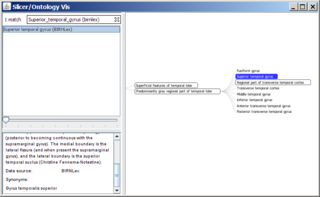Difference between revisions of "FMA (Protege) links to Slicer"
| Line 27: | Line 27: | ||
<h1>Objective</h1> | <h1>Objective</h1> | ||
| − | We are building algorithms to browse protege's frame based ontologies. This capability will allow us to integrate some very extensive anatomy ontologies like the Foundational Model of Anatomy into slicer3. Also, we plan to develop reasoning algorithms to work with physiological ontologies based on Protege's frame based representation. | + | We are building algorithms to browse protege's frame based ontologies. This capability will allow us to integrate some very extensive anatomy ontologies like the Foundational Model of Anatomy into slicer3. Also, we plan to develop reasoning algorithms to work with physiological ontologies of brain based on Protege's frame based representation. |
| Line 35: | Line 35: | ||
<h1>Approach, Plan</h1> | <h1>Approach, Plan</h1> | ||
| − | + | Based on the idea's presented in the paper, "OQAFMA Querying Agent for the Foundational Model of Anatomy", we will build | |
| − | + | a query-engine that allows a software program to navigate through protege ontologies. We will use this capability to develop a ontology browser for FMA. | |
| + | <foo>. | ||
Our plan for the project week is to first try out <bar>,... | Our plan for the project week is to first try out <bar>,... | ||
| Line 45: | Line 46: | ||
<h1>Progress</h1> | <h1>Progress</h1> | ||
| − | + | 1. Integration of FMA browser with Atlas. | |
| + | 2. Integration of Query engine to Ion-Florin et al's physiological ontology of brain. | ||
| + | |||
</div> | </div> | ||
Revision as of 20:08, 20 June 2008
Home < FMA (Protege) links to Slicer
Instructions for Use of this Template
- Please create a new wiki page with an appropriate title for your project using the convention NA-MIC/Projects/Theme-Name/Project-Name
- Copy the entire text of this page into the page created above
- Link the created page into the list of projects for the project event
- Delete this section from the created page
- Send an email to tkapur at bwh.harvard.edu if you are stuck
Key Investigators
- GE: Viswanath Avasarala, Jim Miller
- Harvard: Ion-Florin Talos
- Stanford: Michael Hall.
Objective
We are building algorithms to browse protege's frame based ontologies. This capability will allow us to integrate some very extensive anatomy ontologies like the Foundational Model of Anatomy into slicer3. Also, we plan to develop reasoning algorithms to work with physiological ontologies of brain based on Protege's frame based representation.
Approach, Plan
Based on the idea's presented in the paper, "OQAFMA Querying Agent for the Foundational Model of Anatomy", we will build a query-engine that allows a software program to navigate through protege ontologies. We will use this capability to develop a ontology browser for FMA.
<foo>.
Our plan for the project week is to first try out <bar>,...
Progress
1. Integration of FMA browser with Atlas. 2. Integration of Query engine to Ion-Florin et al's physiological ontology of brain.
References
- Talos I, Rubin D, Halle M, Musen M, Kikinis R. A prototype symbolic model of canonical functional neuroanatomy of the motor system. J Biomed Inform. 2008 Apr;41(2):251-263.
- C. Rosse and J.L.V. Mejino, A reference ontology for biomedical informatics: the Foundational Model of Anatomy. J. Biomed Inform. 36:478-500, 2003.
- P. Mork, J.F. Brinkley, and C. Rosse, OQAFMA querying agent for the Foundational Model of Anatomy: providing flexible and efficient access to a large semantic network. J. Biomed Inform. 36:501-517, 2003.
- Talos I, Rubin D, Halle M, Musen M, Kikinis R. A prototype symbolic model of canonical functional neuroanatomy of the motor system. J Biomed Inform. 2008 Apr;41(2):251-263.

